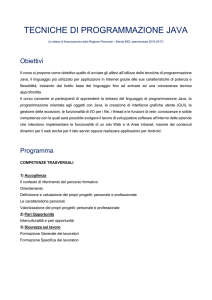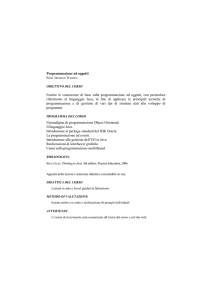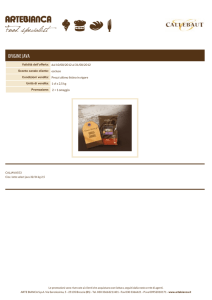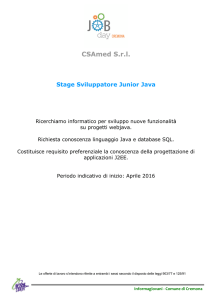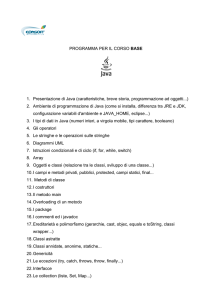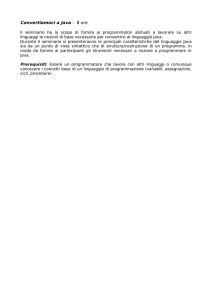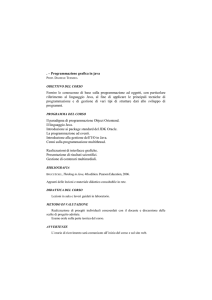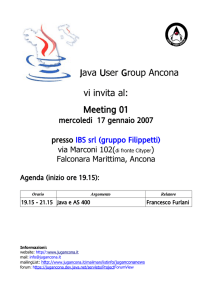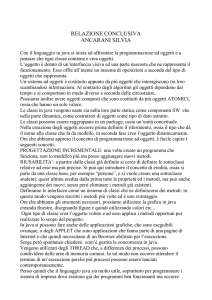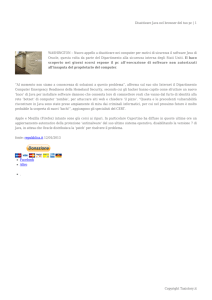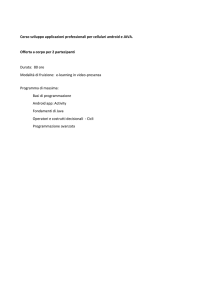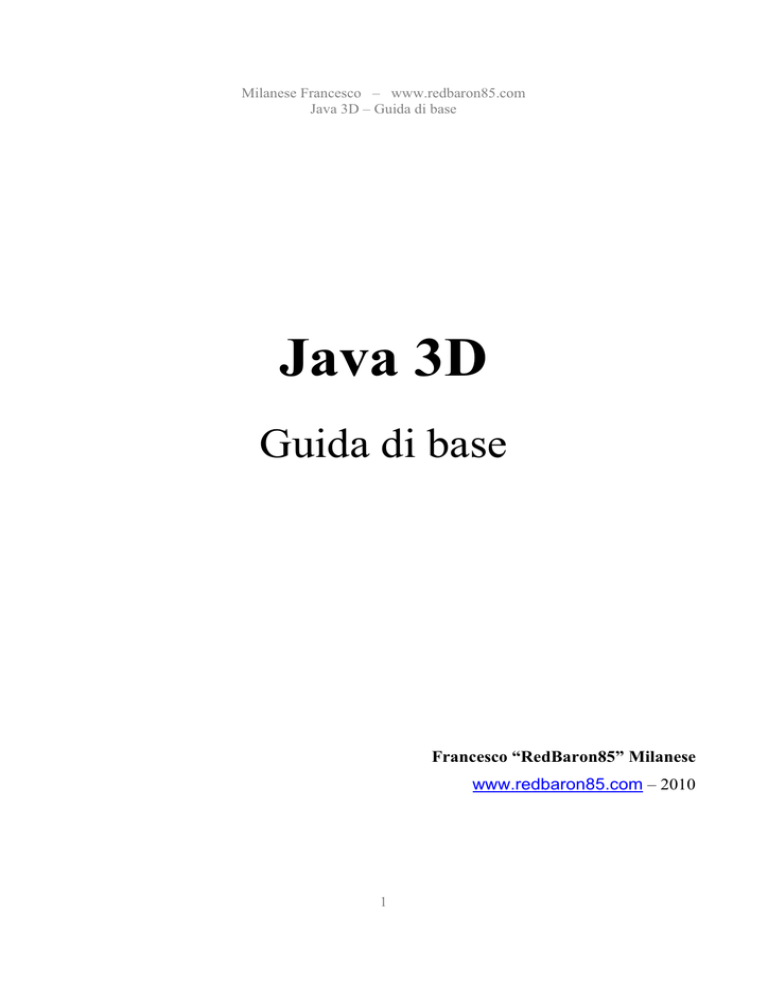
Milanese Francesco – www.redbaron85.com
Java 3D – Guida di base
Java 3D
Guida di base
Francesco “RedBaron85” Milanese
www.redbaron85.com – 2010
1
Milanese Francesco – www.redbaron85.com
Java 3D – Guida di base
Java 3D è un ricco set di API di programmazione di livello medio-alto che consente
di creare facilmente applicazioni con grafica tridimensionale interattiva.
Questa guida parte dalle basi teoriche dello Scene Graph per poi trattare, mediante
esempi pratici, la creazione, il posizionamento e l'animazione di oggetti nell'universo
virtuale di Java 3D, oltre alla gestione della loro resa visiva, l'interazione mediante
mouse e tastiera, l'animazione ed altro ancora.
Francesco Milanese ha tenuto un ciclo di seminari sull’argomento presso
l'Università degli Studi di Catania durante l'A.A. 2008-09.
E' un Blender Foundation Certified Trainer ed ha realizzato e gestisce il sito
www.redbaron85.com, dove pubblica periodicamente tutorial e guide riguardanti la
Computer Grafica 3D.
3
Milanese Francesco – www.redbaron85.com
Java 3D – Guida di base
SOMMARIO
Java 3D................................................................................................................................................... 12
LA COMPUTER GRAFICA 3D ..................................................................................................... 12
LE API DI PROGRAMMAZIONE ................................................................................................ 13
JAVA 3D ............................................................................................................................................ 14
DI COSA ABBIAMO BISOGNO ?................................................................................................. 14
STRUTTURA DELLA GUIDA....................................................................................................... 15
UN SEMPLICE ESEMPIO 2D “FINTO 3D”: WITU................................................................. 17
Lo Scene Graph. Il Simple Universe ................................................................................................... 19
STRUTTURE ED ELEMENTI DELLO SCENE GRAPH .......................................................... 20
ELEMENTI DELLO SCENE GRAPH – IL VIRTUAL UNIVERSE ......................................... 20
ELEMENTI DELLO SCENE GRAPH – IL LOCALE ................................................................ 21
ELEMENTI DELLO SCENE GRAPH – LA SUPERCLASSE NODE ...................................... 21
ELEMENTI DELLO SCENE GRAPH – I GRUPPI .................................................................... 22
ELEMENTI DELLO SCENE GRAPH – LA SUPERCLASSE LEAF ....................................... 22
ELEMENTI DELLO SCENE GRAPH – LA SUPERCLASSE NODECOMPONENT ............ 22
RELAZIONI PADRE-FIGLIO E RELAZIONI REFERENCE .................................................. 23
IL SIMPLE UNIVERSE .................................................................................................................. 23
COMPILARE UN BRANCH GRAPH ........................................................................................... 25
LE CAPABILITY ............................................................................................................................. 25
OGGETTI “VIVI”............................................................................................................................ 26
IL SISTEMA DI RIFERIMENTO DI JAVA 3D........................................................................... 26
UN PRIMO ESEMPIO: UN UNIVERSO VUOTO....................................................................... 27
SECONDO ESEMPIO: POPOLARE L’UNIVERSO................................................................... 28
Il Simple Universe in dettaglio............................................................................................................. 30
PERSONALIZZARE IL SIMPLE UNIVERSE ............................................................................ 30
IL LOCALE....................................................................................................................................... 31
ELEMENTI DEL VIEW BRANCH GRAPH. OPERAZIONI. ................................................... 32
LE NORMALI .................................................................................................................................. 34
IL CLIPPING.................................................................................................................................... 35
L’ESEMPIO “ESEMPIOSIMPLEUNIVERSE”........................................................................... 36
BOUND E SCOPE: INTRODUZIONE ......................................................................................... 36
BOUND E BOUNDINGLEAF......................................................................................................... 37
SCOPE, CON UN PICCOLO INTRUSO....................................................................................... 38
IL BACKGROUND .......................................................................................................................... 39
ANCORA SU BOUND E BACKGROUND .................................................................................. 39
Le classi “matematiche” in Java 3D.................................................................................................... 42
MATEMATICA 3D: CENNI........................................................................................................... 42
LE CLASSI MATEMATICHE IN JAVA E IN JAVA 3D ........................................................... 45
5
Milanese Francesco – www.redbaron85.com
Java 3D – Guida di base
Gruppi. Oggetti visuali di base e da file .............................................................................................. 48
I GRUPPI: BRANCH E TRANSFORM......................................................................................... 49
GLI OGGETTI VISUALI................................................................................................................ 50
GEOMETRIE DI BASE................................................................................................................... 51
GEOMETRIE DI BASE – COLORCUBE..................................................................................... 51
GEOMETRIE DI BASE – BOX ...................................................................................................... 52
GEOMETRIE DI BASE – CONE ................................................................................................... 52
GEOMETRIE DI BASE – CYLINDER ......................................................................................... 53
GEOMETRIE DI BASE – SPHERE............................................................................................... 53
GEOMETRIE DI BASE – TEXT2D............................................................................................... 54
GEOMETRIE DI BASE – TEXT 3D.............................................................................................. 55
GEOMETRIE DA FILE .................................................................................................................. 57
Geometry e le sue sottoclassi ................................................................................................................ 58
GEOMETRY E LE SUE SOTTOCLASSI: PANORAMICA ...................................................... 59
GEOMETRYARRAY E LE SUE SOTTOCLASSI ...................................................................... 59
SOTTOCLASSI DI GEOMETRY ARRAY................................................................................... 60
SOTTOCLASSI DI GEOMETRYARRAY – POINTARRAY..................................................... 61
SOTTOCLASSI DI GEOMETRYARRAY – LINEARRAY ....................................................... 62
SOTTOCLASSI DI GEOMETRYARRAY – TRIANGLEARRAY............................................ 63
SOTTOCLASSI DI GEOMETRYARRAY – QUADARRAY ..................................................... 64
SOTTOCLASSI DI GEOMETRYARRAY – GEOMETRYSTRIPARRAY.............................. 64
SOTTOCLASSI DI GEOMETRYSTRIPARRAY – LINESTRIPARRAY ................................ 65
SOTTOCLASSI DI GEOMETRYSTRIPARRAY – TRIANGLESTRIPARRAY .................... 66
SOTTOCLASSI DI GEOMETRYSTRIPARRAY – TRIANGLEFANARRAY........................ 67
INDEXEDGEOMETRYARRAY E LE SUE SOTTOCLASSI .................................................... 68
GEOMETRYINFO........................................................................................................................... 69
GEOMETRY INFO: UN ESEMPIO .............................................................................................. 71
RASTER ............................................................................................................................................ 73
Le trasformazioni.................................................................................................................................. 74
TRASLAZIONI................................................................................................................................. 75
ROTAZIONI ..................................................................................................................................... 76
RIDIMENSIONAMENTI (SCALING) .......................................................................................... 77
IL PIVOTING ................................................................................................................................... 77
TRASLAZIONI E PIVOTING........................................................................................................ 78
ROTAZIONI E PIVOTING ............................................................................................................ 79
SCALING IN CASCATA................................................................................................................. 81
UN ESEMPIO COMPLETO ........................................................................................................... 82
L’interazione.......................................................................................................................................... 83
I BEHAVIOR .................................................................................................................................... 84
CONDIZIONI DI WAKEUP ........................................................................................................... 86
CREARE DEI SEMPLICI BEHAVIOR: ESEMPI ...................................................................... 87
KEYNAVIGATORBEHAVIOR ..................................................................................................... 88
BOUNDINGLEAF E BOUND DI DIMENSIONE INFINITA..................................................... 90
BEHAVIOR PER IL MOUSE ......................................................................................................... 92
MOUSE BEHAVIOR ....................................................................................................................... 93
6
Milanese Francesco – www.redbaron85.com
Java 3D – Guida di base
IL PICKING...................................................................................................................................... 93
PICKMOUSEBEHAVIOR .............................................................................................................. 94
MOUSEBEHAVIOR e PICKMOUSEBEHAVIOR...................................................................... 95
PICKINGCALLBACK .................................................................................................................... 95
USERDATA. ESTENDERE LE CLASSI DI JAVA 3D................................................................ 97
Le luci ..................................................................................................................................................... 99
I COLORI DEGLI OGGETTI IN JAVA 3D ............................................................................... 100
LE LUCI NELLO SCENE GRAPH ............................................................................................. 100
LA CLASSE LIGHT ...................................................................................................................... 100
AMBIENT LIGHT ......................................................................................................................... 101
DIRECTIONAL LIGHT................................................................................................................ 102
POINT LIGHT................................................................................................................................ 103
SPOT LIGHT .................................................................................................................................. 104
L’ATTENUAZIONE DELLE LUCI............................................................................................. 106
BOUNDING LEAF......................................................................................................................... 107
SCOPE ............................................................................................................................................. 107
LE OMBRE ..................................................................................................................................... 109
L’aspetto visivo degli oggetti.............................................................................................................. 111
COLORI DELLE GEOMETRIE.................................................................................................. 112
I MODELLI DI OMBREGGIATURA ......................................................................................... 113
APPEARANCE E I SUOI ATTRIBUTI....................................................................................... 113
ATTRIBUTI DI APPEARANCE – POINT ATTRIBUTES....................................................... 115
ATTRIBUTI DI APPEARANCE – LINE ATTRIBUTES.......................................................... 115
ATTRIBUTI DI APPEARANCE – POLYGON ATTRIBUTES ............................................... 116
ATTRIBUTI DI APPEARANCE – COLORING ATTRIBUTES ............................................. 116
ATTRIBUTI DI APPEARANCE – TRANSPARENCY ATTRIBUTES .................................. 117
UTILIZZARE PIU’ TECNICHE: UN ESEMPIO ...................................................................... 118
ALTERNATE APPEARANCE ..................................................................................................... 119
MATERIAL..................................................................................................................................... 121
LUCI, ASPETTO E NORMALI DELLE GEOMETRIE........................................................... 122
LE TEXTURES E IL TEXTURE MAPPING ............................................................................. 123
CARICARE UNA TEXTURE ....................................................................................................... 124
IMPOSTARE UNA TEXTURE IN UN APPEARANCE............................................................ 124
IMPOSTARE LE COORDINATE DI UNA TEXTURE ............................................................ 125
TEXCOORDGENERATION ........................................................................................................ 125
IMPOSTARE LE COORDINATE DELLE TEXTURES MANUALMENTE......................... 126
ESEMPI CON LE TEXTURES .................................................................................................... 128
BOUNDARY MODE ...................................................................................................................... 128
PIXEL E TEXEL ............................................................................................................................ 129
Animazioni........................................................................................................................................... 130
ANIMAZIONI DIPENDENTI DAL PUNTO DI VISTA DELL’OSSERVATORE ................ 131
BILLBOARD................................................................................................................................... 132
ORIENTEDSHAPE3D ................................................................................................................... 133
ANIMAZIONI LOD ....................................................................................................................... 135
ANIMAZIONI TIME-BASED....................................................................................................... 137
7
Milanese Francesco – www.redbaron85.com
Java 3D – Guida di base
ALPHA............................................................................................................................................. 139
INTERPOLATOR E LE SUE SOTTOCLASSI .......................................................................... 143
SOTTOCLASSI DI INTERPOLATOR – COLOR INTERPOLATOR ................................... 144
SOTTOCLASSI DI INTERPOLATOR – TRANSPARENCY INTERPOLATOR................. 145
SOTTOCLASSI DI INTERPOLATOR – SWITCH VALUE INTERPOLATOR................... 146
SOTTOCLASSI DI INTERPOLATOR – TRANSFORM INTERPOLATOR ........................ 147
SISTEMI DI RIFERIMENTO: LOCALE E GLOBALE........................................................... 148
SOTTOCLASSI DI TRANSFORM INTERPOLATOR – POSITION INTERPOLATOR.... 149
SOTTOCLASSI DI TRANSFORM INTERPOLATOR – ROTATION INTERPOLATOR . 150
SOTTOCLASSI DI TRANSFORM INTERPOLATOR – SCALE INTERPOLATOR .......... 151
SOTTOCLASSI DI TRANSFORM INTERPOLATOR – PATH INTERPOLATOR ............ 152
AXISANGLE4D E QUATERNIONI ............................................................................................ 153
SOTTOCLASSI DI PATH INTERPOLATOR – POSITION PATH INTERPOLATOR ...... 155
SOTTOCLASSI DI PATH INTERPOLATOR – ROTATION PATH INTERPOLATOR .... 156
SOTTOCLASSI DI PATH INTERPOLATOR – ROTPOSPATH INTERPOLATOR .......... 156
SOTTOCLASSI DI PATH INTERPOLATOR – ROTPOSSCALEPATH INTERPOLATOR
........................................................................................................................................................... 157
ANIMAZIONI “A COMANDO” .................................................................................................. 158
ANIMAZIONI MORPH ................................................................................................................ 160
Extra..................................................................................................................................................... 163
LE COLLISIONI IN JAVA 3D ..................................................................................................... 164
IL METODO GET TRIGGERING PATH E L’OGGETTO SCENE GRAPH PATH ........... 165
SCRIVERE SULLA CANVAS 3D ................................................................................................ 167
I THREAD IN JAVA...................................................................................................................... 168
ANIMAZIONI MEDIANTE THREAD: UN SEMPLICE ESEMPIO ...................................... 175
SET TEXTURE MODE DI TEXTURE ATTRIBUTES............................................................. 178
Appendice ............................................................................................................................................ 180
APPLICAZIONE JAVA 3D DI BASE.......................................................................................... 181
WITU.java ....................................................................................................................................... 183
WITUapp.java................................................................................................................................. 188
PRIMO ESEMPIO ......................................................................................................................... 189
SECONDO ESEMPIO ................................................................................................................... 191
NOMINAL VIEWING PLATFORM ........................................................................................... 193
ESEMPIO SIMPLE UNIVERSE .................................................................................................. 195
ESEMPIO BACKGROUND.......................................................................................................... 198
BACKGROUND CREATO CON SFERA ENORME ................................................................ 200
BACKGROUND CLASSICO........................................................................................................ 202
ESEMPIO COLOR CUBE ............................................................................................................ 205
ESEMPIO BOX............................................................................................................................... 207
ESEMPIO CONE............................................................................................................................ 208
ESEMPIO CYLINDER.................................................................................................................. 209
ESEMPIO SPHERE 1 .................................................................................................................... 210
ESEMPIO SPHERE 2 .................................................................................................................... 211
ESEMPIO TEXT 2D ...................................................................................................................... 212
ESEMPIO TEXT 3D ...................................................................................................................... 214
ESEMPIO POINT ARRAY ........................................................................................................... 216
8
Milanese Francesco – www.redbaron85.com
Java 3D – Guida di base
ESEMPIO LINE ARRAY QUATTRO VERTICI....................................................................... 218
ESEMPIO LINE ARRAY TRE VERTICI................................................................................... 220
ESEMPIO SISTEMA DI RIFERIMENTO.................................................................................. 222
ESEMPIO TRIANGLE ARRAY .................................................................................................. 225
ESEMPIO QUAD ARRAY ............................................................................................................ 227
ESEMPIO LINE STRIP ARRAY ................................................................................................. 230
ESEMPIO TRIANGLE STRIP ARRAY...................................................................................... 233
ESEMPIO TRIANGLE FAN ARRAY ......................................................................................... 236
ESEMPIO INDEXED LINE ARRAY........................................................................................... 239
ESEMPIO INDEXED QUAD ARRAY......................................................................................... 241
ESEMPIO GEOMETRY INFO .................................................................................................... 243
ESEMPIO RASTER ....................................................................................................................... 246
DOWNTOWN ................................................................................................................................. 248
ROTAZIONE PIVOT 1 ................................................................................................................. 250
ROTAZIONE PIVOT 2 ................................................................................................................. 252
ESEMPIO SCALING IN CASCATA ........................................................................................... 255
ESEMPIO ROTO TRAS SCALE ................................................................................................. 257
ESEMPIO BEHAVIOR 1 .............................................................................................................. 259
MIO BEHAVIOR 1 ........................................................................................................................ 261
ESEMPIO BEHAVIOR 2 .............................................................................................................. 264
MIO BEHAVIOR 2 ........................................................................................................................ 266
ESEMPIO BEHAVIOR NAVIGAZIONE ................................................................................... 269
ESEMPIO NAV BEHAVIOR 2..................................................................................................... 271
MIO BEHAVIOR TASTIERA ...................................................................................................... 273
ESEMPIO MOUSE BEHAVIOR.................................................................................................. 276
ESEMPIO PICKING...................................................................................................................... 278
ESEMPIO PICKING CALLBACK .............................................................................................. 280
MIA CLASSE DI PICKING CALLBACK .................................................................................. 282
ESEMPIO PICKING CALLBACK 2........................................................................................... 283
MIA CLASSE DI PICKING CALLBACK 2 ............................................................................... 285
MIO TRANSFORM GROUP ........................................................................................................ 286
ESEMPIO LUCE AMBIENTALE................................................................................................ 287
ESEMPIO LUCE DIREZIONALE............................................................................................... 289
ESEMPIO POINT LIGHT ............................................................................................................ 292
ESEMPIO SPOT LIGHT............................................................................................................... 295
ESEMPIO POINT LIGHT CON SCOPE .................................................................................... 298
ESEMPIO COLORI DELLE GEOMETRIE 1 ........................................................................... 301
ESEMPIO COLORI DELLE GEOMETRIE 2 ........................................................................... 304
ESEMPIO POINT ATTRIBUTES................................................................................................ 306
ESEMPIO LINE ATTRIBUTES................................................................................................... 308
ESEMPIO POLYGON ATTRIBUTES ........................................................................................ 310
ESEMPIO COLORING ATTRIBUTES ...................................................................................... 312
ESEMPIO TRANSPARENCY ATTRIBUTES ........................................................................... 314
ESEMPIO BORDI IN RILIEVO .................................................................................................. 316
ESEMPIO ALTERNATE APPEARANCE.................................................................................. 319
ESEMPIO ALTERNATE APPEARANCE APP 2 ...................................................................... 322
ESEMPIO MATERIAL ................................................................................................................. 326
ESEMPIO TEXTURE 1................................................................................................................. 329
9
Milanese Francesco – www.redbaron85.com
Java 3D – Guida di base
ESEMPIO TEXTURE 2................................................................................................................. 331
ESEMPIO TEXTURE 3................................................................................................................. 333
ESEMPIO TEXTURE 4................................................................................................................. 336
ESEMPIO BOUNDARY MODE................................................................................................... 339
ESEMPIO BILLBOARD ............................................................................................................... 342
ESEMPIO BILLBOARD 2 ............................................................................................................ 345
ESEMPIO ORIENTED SHAPE 3D.............................................................................................. 348
ESEMPIO LOD............................................................................................................................... 351
ESEMPIO COLOR INTERPOLATOR ....................................................................................... 353
ESEMPIO TRANSPARENCY INTERPOLATOR..................................................................... 356
ESEMPIO SWITCH VALUE INTERPOLATOR ...................................................................... 359
ESEMPIO POSITION INTERPOLATOR 1 ............................................................................... 361
ESEMPIO POSITION INTERPOLATOR 2 ............................................................................... 363
ESEMPIO POSITION INTERPOLATOR 3 ............................................................................... 366
ESEMPIO ROTATION INTERPOLATOR................................................................................ 369
ESEMPIO SCALE INTERPOLATOR ........................................................................................ 371
ESEMPIO QUATERNIONI .......................................................................................................... 373
ESEMPIO POSITION PATH INTERPOLATOR ...................................................................... 376
ESEMPIO ROTPOSPATHINTERPOLATOR ........................................................................... 379
ESEMPIO ROTPOSSCALEPATHINTERPOLATOR.............................................................. 382
ESEMPIO ICBM --- MAIN ....................................................................................................... 385
ESEMPIO ICBM --- GUI........................................................................................................... 390
ESEMPIO MORPH BEHAVIOR ................................................................................................. 397
BEHAVIOR COLLISIONE .......................................................................................................... 400
SIMULATORE --- MAIN .............................................................................................................. 401
SIMULATORE --- THREAD CONTROLLO 1 .......................................................................... 402
SIMULATORE --- THREAD FRAME 1...................................................................................... 403
SIMULATORE --- FRAME SIMULATORE 1 ........................................................................... 404
SIMULATORE --- MIO BEHAVIOR TASTIERA..................................................................... 406
SIMULATORE --- SCENA 3D...................................................................................................... 410
PIANETA TERRA.......................................................................................................................... 412
10
Milanese Francesco – www.redbaron85.com
Java 3D – Guida di base
TRASLAZIONI E PIVOTING
La traslazione è il caso più semplice: se aggiungiamo un TransformGroup (che chiameremo ad
esempio tg1), con una sua trasformazione di traslazione (che chiameremo ad esempio t3d1), in cima
al Content Branch Graph, la traslazione verrà effettuata relativamente all'origine del sistema (il
pivot, in questo caso, è l'origine).
Il vettore di traslazione di t3d1 parte quindi dall'origine e identifica un nuovo punto di arrivo
nello spazio. Chiamiamo tale punto P1.
Un nuovo oggetto visuale collegato, come figlio, a tg1, verrà quindi centrato in P1.
Se a tg1 colleghiamo ora, come figlio, un nuovo TransformGroup (tg2), con una sua
trasformazione di traslazione (t3d2), il vettore di t3d2 partirà a P1.
Le coordinate di arrivo di t3d2, in riferimento all'origine dell'universo virtuale di Java3D,
vengono calcolate con la somma vettoriale dei vettori di t3d1 e t3d2 ed identificano un secondo
punto P2 (coordinate globali di P2: t3d1 + t3d2; coordinate locali, cioè in riferimento al nodo padre
di P2: t3d2).
Un oggetto visuale collegato, come figlio, a tg2, verrà centrato in P2.
79
Milanese Francesco – www.redbaron85.com
Java 3D – Guida di base
ROTAZIONI E PIVOTING
Finora abbiamo visto la rotazione di oggetti che si trovavano nell'origine; in quel caso, il pivot
della trasformazione coincideva con il centro dell'oggetto.
Quando però un oggetto viene traslato, bisogna fare attenzione a dove posizionare la
trasformazione di rotazione, al fine di evitare effetti indesiderati.
Sostanzialmente, quando bisogna ruotare un oggetto bisogna porsi la seguente domanda: 'rispetto
a cosa lo stiamo ruotando' ?
Ebbene, se dobbiamo ruotare un oggetto intorno al suo centro, possiamo applicare la
trasformazione di rotazione direttamente al TG che controlla la posizione dell'oggetto, cioè suo
padre.
Nell'esempio 'RotazionePivot1' è possibile vedere un cubo spostato in avanti rispetto al punto di
vista dell'osservatore di 5 unità e ruotato, intorno all'asse Y , di ʌ/4 radianti; per far questo, si è reso
necessario creare due TG: il primo per traslare il cubo, il secondo per ruotarlo intorno al suo centro.
Per ruotare l'oggetto intorno ad un altro punto, un punto esterno, cosa bisogna fare ?
80
Milanese Francesco – www.redbaron85.com
Java 3D – Guida di base
Soffermiamoci su come vengono colorate le due sfere.
La sfera nell'origine ha colore diffuso VERDE (0, 1, 0), la luce ha colore CIANO (0, 1, 1), dunque
il colore visibile della sfera sarà VERDE, eccezion fatta per la regione del riflesso speculare: il colore
speculare, che di default è bianco, verrà reso come CIANO, cioè il colore della fonte luminosa, che ha
canale R nullo.
La seconda sfera ha colore diffuso ROSSO (1, 0, 0), dunque non subirà l'influenza della luce sul
colore diffuso e verrà resa nera, eccezion fatta per la regione del riflesso speculare, che verrà resa color
CIANO, per i motivi esposti precedentemente.
POINT LIGHT
Il funzionamento di una PointLight è in tutto e per tutto simile a quello di una lampadina a bulbo:
una sorgente di luce omnidirezionale, la cui intensità luminosa decresce (se lo si desidera, in Java3D)
all'aumentare della distanza.
Costruttori:
x
PointLight();
x
PointLight(Color3f color, Point3f position, Point3f
attenuation);
x
PointLight(boolean lightOn, Color3f color, Point3f position,
Point3f attenuation).
L'attenuazione è calcolata con un'equazione i cui parametri possono essere modificati; a tal
proposito, PointLight mette a disposizione due metodi:
x
setAttenuation(float constant, float linear, float quadratic);
x
setAttenutation(Point3f attenuation).
Una PointLight influisce sui colori diffuso e speculare degli oggetti che si trovano nel suo bound
d'azione.
104
Milanese Francesco – www.redbaron85.com
Java 3D – Guida di base
Nel file di esempio PointLight abbiamo una sorgente luminosa PointLight di colore MAGENTA
posta nell'origine.
Le 5 sfere presenti hanno colore diffuso ROSSO e colore speculare BIANCO (default), quindi con
la luce MAGENTA il colore diffuso finale sarà il ROSSO e quello speculare il MAGENTA.
SPOT LIGHT
La classe SpotLight è figlia di PointLight: in effetti, è una fonte di luce che agisce in una
determinata direzione e all'interno di un cono d'azione.
Costruttori:
x
SpotLight();
x
SpotLight(Color3f color, Point3f position, Point3f
attenuation, Vector3f direction, float spreadAngle, float
concentration);
x
SpotLight(boolean lightOn, Color3f color, Point3f position,
Point3f attenuation, Vector3f direction, float spreadAngle,
float concentration).
La direzione è espressa mediante un vettore.
Nel determinare l'intensità luminosa in un dato punto del cono d'azione non entra in gioco solo la
distanza dalla sorgente, ma anche l'angolo formato dal vettore direzione e dal vettore passante per la
sorgente e il punto interno al cono preso in esame.
Il valore di concentration varia da 0.0 (distribuzione uniforme) a 128.0 (luce concentrata).
105
Milanese Francesco – www.redbaron85.com
Java 3D – Guida di base
AXISANGLE4D
Un AxisAngle4d è un oggetto AxisAngle, utilizzato per descrivere le rotazioni nello spazio 3D
con 4 valori double: 3 componenti di un vettore e un angolo.
In generale, con le tre componenti double identifichiamo un vettore che, da un punto di partenza,
porta ad una destinazione, mediante i valori x, y e z trattati singolarmente (cioè secondo le regole della
somma vettoriale).
Il vettore però, in questo caso, non verrà utilizzato per identificare un punto, ma un asse di
rotazione.
L'asse di rotazione viene calcolato sulla base delle coordinate locali dell'oggetto.
Il valore dell'angolo rappresenta l'entità della rotazione intorno a tale asse.
Costruttori:
x
AxisAngle4d;
x
AxisAngle4d(Vector3d axis, double angle);
x
AxisAngle4d(double[] a);
x
AxisAngle4d(double x, double y, double z, double angle);
x
AxisAngle4d(AxisAngle4d a1);
x
AxisAngle4f a1); .
155
Milanese Francesco – www.redbaron85.com
Java 3D – Guida di base
E' quindi possibile modificare la posizione e l'orientamento dell'utente/osservatore mediante i
tasti freccia e WASD.
A questo movimento, che dipende dall'utente, va sommata la traslazione in avanti effettuata
autonomamente dal programma se il valore di 'potenza reattore' è maggiore di 0 (valore che può
essere incrementato o decrementato, in una scala che va da 0 a 110, mediante i tasti + e í; il valore
massimo è stato impostato a 110 per motivi 'storici', in quanto questa era la velocità raggiungibile con i
postbruciatori accesi nella maggior parte dei simulatori di volo).
Provate, ad esempio, a ruotare l'osservatore verso il basso e a destra e a premere il tasto +.
Il flusso di esecuzione del programma è un po’ particolare ma serve ad illustrare come combinare
Behavior per l'interazione da tastiera (con animazioni proprie) e thread concorrenti (con un thread
che può modificare alcune proprietà dell'universo virtuale).
178
Milanese Francesco – www.redbaron85.com
Java 3D – Guida di base
SET TEXTURE MODE DI TEXTURE ATTRIBUTES
Tra gli attributi dell'aspetto visivo degli oggetti vi è TextureAttributes, che si occupa di definire
in dettaglio alcuni parametri del processo di texture mapping.
Tali parametri sono:
x
Texture Mode , che esamineremo successivamente;
x
Combine Mode , che si occupa di definire l'operazione ‘combine' quando il parametro
precedente, TextureMode, è impostato, appunto, a ‘COMBINE’;
x
CombineColorSource, CombineColorFunction e CombineScaleFactor, che si occupano
di parametri supplementari legati sempre all'operazione ‘combine’;
x
Transform , che specifica la trasformazione utilizzata per trasformare (traslare, ruotare,
ridimensionare) le coordinate delle texture prima di applicare la texture ad un oggetto;
x
Blend Color , che specifica un colore uniforme;
x
Perspective Correction , che permette di scegliere il modello di correzione prospettica
utilizzato;
x
Texture Color Table , che definisce una look up table da impostare prima di applicare il
texture mode.
In questa sezione prenderemo in esame solo il primo parametro, TextureMode.
TextureMode si occupa di definire come verranno combinati i colori dell'oggetto e quelli della
texture da applicare all'oggetto.
Le opzioni possibili sono:
x
MODULATE : combina il colore dell'oggetto con quello della texture;
x
DECAL : la texture viene applicata sul colore dell'oggetto ‘come un'etichetta adesiva’ (decal);
interessante per via della gestione implicita delle trasparenze eventualmente presenti nella
texture;
x
BLEND : combina il colore ‘blend color’ della texture con quello dell'oggetto;
x
REPLACE : il colore dell'oggetto viene sostituito da quello della texture;
179
Milanese Francesco – www.redbaron85.com
Java 3D – Guida di base
PolygonAttributes polyAttrib = new PolygonAttributes();
polyAttrib.setCullFace(PolygonAttributes.CULL_NONE);
polyAttrib.setBackFaceNormalFlip(true);
textAppear.setPolygonAttributes(polyAttrib);
*/
tgRotazione.addChild(testo2D);
objRoot.addChild(tgRotazione);
return objRoot;
}
}
214
Milanese Francesco – www.redbaron85.com
Java 3D – Guida di base
ESEMPIO TEXT 3D
// Milanese Francesco --- Java 3D - Guida di base --- www.redbaron85.com
/*
Questo esempio mostra come inserire nel Content Branch Graph un oggetto "nativo" di Java3D,
un Testo 3D, ruotato ma non spostato, che é una Shape3D a tutti gli effetti dove bisogna
specificare Geometry e Apperance (e l'esempio mostra come fare).
*/
import java.awt.*;
import javax.swing.*;
import javax.vecmath.*; // Stavolta questo ci serve per Point3f, all'interno di Text3D
import javax.media.j3d.*;
import com.sun.j3d.utils.universe.*;
import com.sun.j3d.utils.geometry.*;
public class EsempioText3D extends JFrame
{
public static void main(String [] args)
{
EsempioText3D et3d = new EsempioText3D();
et3d.setVisible(true);
}
public EsempioText3D()
{
this.setDefaultCloseOperation(JFrame.EXIT_ON_CLOSE);
this.setSize(300, 300);
this.setLocation(100, 100);
this.setTitle("Java 3D, esempio Text3D. Milanese Francesco, www.redbaron85.com");
GraphicsConfiguration config = SimpleUniverse.getPreferredConfiguration();
Canvas3D c3D = new Canvas3D(config);
SimpleUniverse sU = new SimpleUniverse(c3D);
sU.getViewingPlatform().setNominalViewingTransform();
BranchGroup scena = creaLoSceneGraph();
scena.compile();
sU.addBranchGraph(scena);
this.getContentPane().add(c3D,BorderLayout.CENTER);
}
public BranchGroup creaLoSceneGraph()
{
BranchGroup objRoot = new BranchGroup();
Transform3D t3D = new Transform3D();
t3D.setTranslation(new Vector3f(0.0f, 0.0f, -3.0f));
TransformGroup tgTraslazione = new TransformGroup(t3D);
Transform3D rotazione1 = new Transform3D();
rotazione1.rotY(Math.PI/4.0);
Transform3D rotazione2 = new Transform3D();
rotazione2.rotX(-Math.PI/11.0);
rotazione2.mul(rotazione1);
TransformGroup tgRotazione = new TransformGroup(rotazione2);
// INIZIA LA FASE DI CREAZIONE DEL TESTO 3D: PRIMA SI CREA UN APPEARANCE,
// POI LA GEOMETRIA, INFINE UN OGGETTO SHAPE3D CON SIFFATTE APPEARANCE E
GEOMETRY:
215
Milanese Francesco – www.redbaron85.com
Java 3D – Guida di base
{
TGtarget.getTransform(t3dAux);
t3dAux2.setTranslation(new Vector3f(0.0f, 0.0f, -1.0f));
t3dAux.mul(t3dAux2);
TGtarget.setTransform(t3dAux);
}
else if(codiceEvento == KeyEvent.VK_D) // Tasto D: spostamento laterale
verso destra
{
TGtarget.getTransform(t3dAux);
t3dAux2.setTranslation(new Vector3f(1.0f, 0.0f, 0.0f));
t3dAux.mul(t3dAux2);
TGtarget.setTransform(t3dAux);
}
else if(codiceEvento == KeyEvent.VK_UP) // Freccia in alto: ROTAZIONE
verso l'alto (rotazione intorno all'asse X)
{
TGtarget.getTransform(t3dAux);
t3dAux2.rotX(Math.PI/18);
t3dAux.mul(t3dAux2);
TGtarget.setTransform(t3dAux);
}
else if(codiceEvento == KeyEvent.VK_DOWN) // Freccia in alto:
ROTAZIONE verso il basso (rotazione intorno all'asse X)
{
TGtarget.getTransform(t3dAux);
t3dAux2.rotX(-Math.PI/18);
t3dAux.mul(t3dAux2);
TGtarget.setTransform(t3dAux);
}
else if(codiceEvento == KeyEvent.VK_LEFT) // Freccia in alto: ROTAZIONE
verso sinistra (rotazione intorno all'asse Z)
{
TGtarget.getTransform(t3dAux);
t3dAux2.rotY(Math.PI/18);
t3dAux.mul(t3dAux2);
TGtarget.setTransform(t3dAux);
}
else if(codiceEvento == KeyEvent.VK_RIGHT) // Freccia in alto:
ROTAZIONE verso destra (rotazione intorno all'asse Z)
{
TGtarget.getTransform(t3dAux);
t3dAux2.rotY(-Math.PI/18);
t3dAux.mul(t3dAux2);
TGtarget.setTransform(t3dAux);
}
}
}
}
// RESETTO il trigger di questo behavior
this.wakeupOn(new WakeupOnAWTEvent(KeyEvent.KEY_PRESSED));
}
}
276
Milanese Francesco – www.redbaron85.com
Java 3D – Guida di base
ESEMPIO MOUSE BEHAVIOR
// Milanese Francesco --- Java 3D - Guida di base --- www.redbaron85.com
/*
Questo esempio mostra come interagire con la scena 3D mediante i tasti del mouse:
- tenendo premuto il tasto sinistro, muovendo il mouse si provoca la rotazione dell'oggetto;
- tenendo premuto il tasto centrale, muovendo il mouse si provoca la traslazione dell'oggetto lungo l'asse Z;
- tenendo premuto il tasto destro, muovendo il mouse si provoca la rotazione dell'oggetto sul piano XY.
Qui si fa uso dei Behavior per il mouse "nativi" di Java3D: MouseTranslate, MouseRotate, MouseZoom.
In questo esempio si fa uso del KeyNavigatorBehavior di Java3D per navigare nello Spazio Virtuale.
*/
import java.awt.*;
import javax.swing.*;
import javax.vecmath.*;
import javax.media.j3d.*;
import com.sun.j3d.utils.universe.*;
import com.sun.j3d.utils.geometry.*;
import com.sun.j3d.utils.behaviors.keyboard.*;
import com.sun.j3d.utils.behaviors.mouse.*;
public class EsempioMouseBehavior extends JFrame
{
public static void main(String[] args)
{
EsempioMouseBehavior emb = new EsempioMouseBehavior();
emb.setVisible(true);
}
public EsempioMouseBehavior()
{
this.setDefaultCloseOperation(JFrame.EXIT_ON_CLOSE);
this.setLocation(100, 100);
this.setSize(400, 400);
this.setTitle("Esempio Mouse Behavior; Milanese Francesco; www.redbaron85.com");
GraphicsConfiguration config = SimpleUniverse.getPreferredConfiguration();
Canvas3D canvas3D = new Canvas3D(config);
this.getContentPane().add(canvas3D,BorderLayout.CENTER);
BranchGroup scene = createSceneGraph();
SimpleUniverse simpleU = new SimpleUniverse(canvas3D);
simpleU.getViewer().getView().setBackClipDistance(10000);
simpleU.getViewer().getView().setFrontClipDistance(0.1);
TransformGroup vpTG = simpleU.getViewingPlatform().getViewPlatformTransform();
Transform3D t3d = new Transform3D();
t3d.setTranslation(new Vector3f(0.0f, 2.0f, 4.0f));
vpTG.setTransform(t3d);
KeyNavigatorBehavior keyNavBeh = new KeyNavigatorBehavior(vpTG);
keyNavBeh.setSchedulingBounds(new BoundingSphere(new Point3d(),1000.0));
scene.addChild(keyNavBeh);
scene.compile();
simpleU.addBranchGraph(scene);
}
private BranchGroup createSceneGraph()
277
Milanese Francesco – www.redbaron85.com
Java 3D – Guida di base
// ma con trasparenza al 0.5 (su una scala da 0 a 1)
objRoot.addChild(new com.sun.j3d.utils.geometry.Box(0.4f, 0.6f, 0.2f,
creaAppearanceTransparencyAttributes()));
// Aggiungo un pavimento di riferimento alla scena
objRoot.addChild(this.creaRiferimento());
// Restituisco il tutto
return objRoot;
}
private Appearance creaAppearanceTransparencyAttributes()
{
// Creo un nuovo oggetto Appearance
Appearance app = new Appearance();
// Creo un nuovo oggetto TransparencyAttributes, specificando il metodo di rendering della trasparenza e
l'ammontare della stessa
TransparencyAttributes ta = new TransparencyAttributes(TransparencyAttributes.NICEST, 0.5f);
// Imposto come TransparencyAttributes dell'Appearance l'oggetto TransparencyAttributes appena definito
app.setTransparencyAttributes(ta);
// Restituisco l'Appearance
return app;
}
private Shape3D creaRiferimento()
{
LineArray landGeom = new LineArray(44, GeometryArray.COORDINATES|GeometryArray.COLOR_3);
float l = -50.0f;
for(int c=0; c<44; c+=4)
{
landGeom.setCoordinate(c+0, new Point3f(-50.0f,0.0f,l));
landGeom.setCoordinate(c+1, new Point3f(50.0f,0.0f,l));
landGeom.setCoordinate(c+2, new Point3f(l,0.0f,-50.0f));
landGeom.setCoordinate(c+3, new Point3f(l,0.0f,50.0f));
l += 10.0f;
}
Color3f c = new Color3f(0.1f,0.8f,0.1f);
for(int i=0; i<44; i++) landGeom.setColor(i,c);
return new Shape3D(landGeom);
}
}
316
Milanese Francesco – www.redbaron85.com
Java 3D – Guida di base
ESEMPIO BORDI IN RILIEVO
// Milanese Francesco --- Java 3D - Guida di base --- www.redbaron85.com
import java.awt.*;
import javax.swing.*;
import javax.vecmath.*;
import javax.media.j3d.*;
import com.sun.j3d.utils.universe.*;
import com.sun.j3d.utils.geometry.*;
import com.sun.j3d.utils.behaviors.keyboard.*;
public class BordiInRilievo extends JFrame
{
public static void main(String[] args)
{
BordiInRilievo bir = new BordiInRilievo();
bir.setVisible(true);
}
public BordiInRilievo()
{
this.setDefaultCloseOperation(JFrame.EXIT_ON_CLOSE);
this.setLocation(100, 100);
this.setSize(400, 400);
this.setTitle("Esempio bordi in rilievo; Milanese Francesco; www.redbaron85.com");
GraphicsConfiguration config = SimpleUniverse.getPreferredConfiguration();
Canvas3D canvas3D = new Canvas3D(config);
this.getContentPane().add(canvas3D,BorderLayout.CENTER);
BranchGroup scene = createSceneGraph();
SimpleUniverse simpleU = new SimpleUniverse(canvas3D);
simpleU.getViewer().getView().setBackClipDistance(10000);
simpleU.getViewer().getView().setFrontClipDistance(0.1);
TransformGroup vpTG = simpleU.getViewingPlatform().getViewPlatformTransform();
Transform3D t3d = new Transform3D();
t3d.setTranslation(new Vector3f(0.0f,0.3f,0.0f));
vpTG.setTransform(t3d);
KeyNavigatorBehavior keyNavBeh = new KeyNavigatorBehavior(vpTG);
keyNavBeh.setSchedulingBounds(new BoundingSphere(new Point3d(),1000.0));
scene.addChild(keyNavBeh);
scene.compile();
simpleU.addBranchGraph(scene);
}
private BranchGroup createSceneGraph()
{
BranchGroup objRoot = new BranchGroup();
objRoot.addChild(this.creaRiferimento());
objRoot.addChild(creaConi(2.0f, 5.0f));
return objRoot;
}
// Metodo per la creazione di un TransformGroup e dei coni suoi figli
private TransformGroup creaConi(float radius, float height)
{
// Creazione di un TransformGroup con trasformazione di traslazione
317
Milanese Francesco – www.redbaron85.com
Java 3D – Guida di base
// (per permetterci di visualizzare subito i coni)
Vector3f vettore = new Vector3f(0.0f, 0.0f, -10.0f);
Transform3D t3d = new Transform3D();
t3d.setTranslation(vettore);
TransformGroup tg = new TransformGroup(t3d);
// Creo, con un metodo esterno, un'appearance per la visualizzazione delle linee
// (modalità di resa dei poligoni POLYGON.LINE) con spessore 2 e colore blu
Appearance blueColorAppearance = getBlueColorAppearance();
// Creo, con un metodo esterno, un'appearance per la visualizzazione delle facce
// con colore rosso e valore di opacità 0.5
Appearance redColorAppearance = getredColorAppearance();
// Creo due coni con raggio e altezza dati ed impostando per il primo un'appearance
// rossa semitrasparente (ottenuta con getredColorAppearance),
// per il secondo l'appearance "fil di ferro" blu ottenuta con getBlueColorAppearance()
Cone cono = new Cone(radius, height);
cono.setAppearance(redColorAppearance);
Cone secondoCono = new Cone(radius, height);
secondoCono.setAppearance(blueColorAppearance);
// Aggiungo i due coni al TransformGroup e restituisco il Transform Group
tg.addChild(cono);
tg.addChild(secondoCono);
return tg;
}
// Creo un'appearance "fil di ferro" blu
private Appearance getBlueColorAppearance()
{
// Creo un oggetto Appearance
Appearance blueColorAppearance=new Appearance();
// Creo gli attributi di resa dei poligoni per l'appearance: imposto cull_none
// e resa "fil di ferro" o "struttura" (POLYGON_LINE)
PolygonAttributes polygonAttributes = new PolygonAttributes(PolygonAttributes.POLYGON_LINE,
PolygonAttributes.CULL_NONE, 0.0f);
blueColorAppearance.setPolygonAttributes(polygonAttributes);
// Creo gli attributi per colorare l'appearance, in questo caso imposto il colore blu
ColoringAttributes blueColoring=new ColoringAttributes();
blueColoring.setColor(0.0f,0.0f,1.0f);
blueColorAppearance.setColoringAttributes(blueColoring);
// Imposto la modalità di resa delle linee per questa Appearance, mettendo come spessore "2.0f"
LineAttributes lineAttrib=new LineAttributes();
lineAttrib.setLineWidth(2.0f);
blueColorAppearance.setLineAttributes(lineAttrib);
// Restituisco l'appearance così definita
return blueColorAppearance;
}
// Creo un'appearance trasparente rossa
private Appearance getredColorAppearance()
{
// Creo un oggetto Appearance
Appearance redColorAppearance=new Appearance();
// Creo l'attributo per gestire la trasparenza di questa appearance,
// mettendo come valore di opacità 0.5
318
Milanese Francesco – www.redbaron85.com
Java 3D – Guida di base
TransparencyAttributes transparencyAttributes = new
TransparencyAttributes(TransparencyAttributes.NICEST, 0.5f);
redColorAppearance.setTransparencyAttributes(transparencyAttributes);
// Creo gli attributi per colorare l'appearance, in questo caso imposto il colore rosso
ColoringAttributes redColoring=new ColoringAttributes();
redColoring.setColor(1.0f,0.0f,0.0f);
redColorAppearance.setColoringAttributes(redColoring);
// Restituisco l'appearance così definita
return redColorAppearance;
}
private Shape3D creaRiferimento()
{
LineArray landGeom = new LineArray(44, GeometryArray.COORDINATES|GeometryArray.COLOR_3);
float l = -50.0f;
for(int c=0; c<44; c+=4)
{
landGeom.setCoordinate(c+0, new Point3f(-50.0f,0.0f,l));
landGeom.setCoordinate(c+1, new Point3f(50.0f,0.0f,l));
landGeom.setCoordinate(c+2, new Point3f(l,0.0f,-50.0f));
landGeom.setCoordinate(c+3, new Point3f(l,0.0f,50.0f));
l += 10.0f;
}
Color3f c = new Color3f(0.1f,0.8f,0.1f);
for(int i=0; i<44; i++) landGeom.setColor(i,c);
return new Shape3D(landGeom);
}
}
319
Milanese Francesco – www.redbaron85.com
Java 3D – Guida di base
DistanceLOD oggettoLoD = new DistanceLOD(arrayDiDistanze);
oggettoLoD.addSwitch(oggettoSwitch);
oggettoLoD.setSchedulingBounds(new BoundingSphere());
// Aggiungo l'oggetto DistanceLoD e l'oggetto Switch alla scena
objRoot.addChild(oggettoLoD);
objRoot.addChild(oggettoSwitch);
// Aggiungo alla scena una "griglia" di riferimento" ( un passo: 10 unità Java3D)
objRoot.addChild(this.disegnaGriglia());
// Restituisco lo Scene Graph così definito
return objRoot;
}
private Shape3D disegnaGriglia() {
LineArray rif = new LineArray(132, GeometryArray.COORDINATES | GeometryArray.COLOR_3);
float l = -50.0f;
for(int x=0; x<44; x+=4)
{
rif.setCoordinate(x+0, new Point3f(-50.0f, 0.0f, l));
rif.setCoordinate(x+1, new Point3f(50.0f, 0.0f, l));
rif.setCoordinate(x+2, new Point3f(l, 0.0f, -50.0f));
rif.setCoordinate(x+3, new Point3f(l, 0.0f, 50.0f));
l+=10.0f;
}
l = -50.0f;
for(int y=44; y<88; y+=4)
{
rif.setCoordinate(y+0, new Point3f(-50.0f, l, 0.0f));
rif.setCoordinate(y+1, new Point3f(50.0f, l, 0.0f));
rif.setCoordinate(y+2, new Point3f(l, -50.0f, 0.0f));
rif.setCoordinate(y+3, new Point3f(l, 50.0f, 0.0f));
l+=10.0f;
}
l = -50.0f;
for(int z=88; z<132; z+=4)
{
rif.setCoordinate(z+0, new Point3f(0.0f, -50.0f, l));
rif.setCoordinate(z+1, new Point3f(0.0f, 50.0f, l));
rif.setCoordinate(z+2, new Point3f(0.0f, l, -50.0f));
rif.setCoordinate(z+3, new Point3f(0.0f, l, 50.0f));
l+=10.0f;
}
Color3f xc = new Color3f(0.1f, 0.9f, 0.1f);
Color3f yc = new Color3f(0.9f, 0.1f, 0.1f);
Color3f zc = new Color3f(0.1f, 0.1f, 0.9f);
for(int x=0; x<44; x++) rif.setColor(x,xc);
for(int y=44; y<88; y++) rif.setColor(y,yc);
for(int z=88; z<132; z++) rif.setColor(z,zc);
return new Shape3D(rif);
}
}
353
Milanese Francesco – www.redbaron85.com
Java 3D – Guida di base
ESEMPIO COLOR INTERPOLATOR
// Milanese Francesco --- Java 3D - Guida di base --- www.redbaron85.com
/*
Questo esempio mostra come generare animazioni time-based, indipendenti dalle azioni dell'utente.
In particolare, qui il colore del materiale di un oggetto verrà modificato mediante ColorInterpolator.
In questo esempio si fa uso del KeyNavigatorBehavior di Java3D per navigare nello Spazio Virtuale.
*/
import java.awt.*;
import javax.swing.*;
import javax.vecmath.*;
import javax.media.j3d.*;
import com.sun.j3d.utils.universe.*;
import com.sun.j3d.utils.geometry.*;
import com.sun.j3d.utils.behaviors.keyboard.*;
public class EsempioColorInterpolator extends JFrame
{
public static void main(String[] args)
{
EsempioColorInterpolator eci = new EsempioColorInterpolator();
eci.setVisible(true);
}
public EsempioColorInterpolator()
{
this.setDefaultCloseOperation(JFrame.EXIT_ON_CLOSE);
this.setLocation(100, 100);
this.setSize(400, 400);
this.setTitle("EsempioColorInterpolator; Milanese Francesco; www.redbaron85.com");
GraphicsConfiguration config = SimpleUniverse.getPreferredConfiguration();
Canvas3D canvas3D = new Canvas3D(config);
this.getContentPane().add(canvas3D,BorderLayout.CENTER);
BranchGroup scene = createSceneGraph();
SimpleUniverse simpleU = new SimpleUniverse(canvas3D);
simpleU.getViewer().getView().setBackClipDistance(10000);
simpleU.getViewer().getView().setFrontClipDistance(0.1);
TransformGroup vpTG = simpleU.getViewingPlatform().getViewPlatformTransform();
Transform3D t3d = new Transform3D();
t3d.setTranslation(new Vector3f(0.0f,0.3f,2.0f));
vpTG.setTransform(t3d);
KeyNavigatorBehavior keyNavBeh = new KeyNavigatorBehavior(vpTG);
keyNavBeh.setSchedulingBounds(new BoundingSphere(new Point3d(),1000.0));
scene.addChild(keyNavBeh);
scene.compile();
simpleU.addBranchGraph(scene);
}
private BranchGroup createSceneGraph()
{
BranchGroup objRoot = new BranchGroup();
objRoot.addChild(this.conoCambiaColore());
objRoot.addChild(this.creaRiferimento());
354
Milanese Francesco – www.redbaron85.com
Java 3D – Guida di base
objRoot.addChild(this.creaUnaLucePointLight());
return objRoot;
}
private BranchGroup conoCambiaColore()
{
// Creo la radice di questo gruppo
BranchGroup objRootInterno = new BranchGroup();
// Creo un Appearance e un Material
Appearance app = new Appearance();
Material mtl = new Material();
// Devo specificare quale colore di questo materiale é il colore TARGET del Position Interpolator; devo,
inoltre, impostare le Capability
mtl.setDiffuseColor(new Color3f(1.0f, 1.0f, 1.0f));
mtl.setColorTarget(Material.DIFFUSE);
mtl.setCapability(Material.ALLOW_COMPONENT_WRITE);
// Imposto il materiale così definito come materiale dell'Appearance
app.setMaterial(mtl);
// Creo l'Alpha: 1 secondo per ogni fase
Alpha mioAlpha = new Alpha(-1, Alpha.INCREASING_ENABLE | Alpha.DECREASING_ENABLE, 0,
0, 1000, 0, 1000, 1000, 0, 1000);
// Creo il Target: un TransformGroup, con le capability impostate
TransformGroup tg = new TransformGroup();
tg.setCapability(TransformGroup.ALLOW_TRANSFORM_WRITE);
// Creo l'Interpolatore, ne imposto i dati e il bound d'azione
ColorInterpolator ci = new ColorInterpolator(mioAlpha, mtl, new Color3f(1.0f, 1.0f, 1.0f), new
Color3f(1.0f, 1.0f, 0.0f));
ci.setSchedulingBounds(new BoundingSphere());
// Creo il Cono, gli associo l'Appearance con il relativo Material, e lo aggancio al TransformGroup
Cone mioCono = new Cone(2.0f, 5.0f);
mioCono.setAppearance(app);
tg.addChild(mioCono);
// Assemblo la scena
objRootInterno.addChild(tg);
objRootInterno.addChild(ci);
// Restituisco il gruppo
return objRootInterno;
}
private Shape3D creaRiferimento()
{
LineArray landGeom = new LineArray(44, GeometryArray.COORDINATES|GeometryArray.COLOR_3);
float l = -50.0f;
for(int c=0; c<44; c+=4)
{
landGeom.setCoordinate(c+0, new Point3f(-50.0f,0.0f,l));
landGeom.setCoordinate(c+1, new Point3f(50.0f,0.0f,l));
landGeom.setCoordinate(c+2, new Point3f(l,0.0f,-50.0f));
landGeom.setCoordinate(c+3, new Point3f(l,0.0f,50.0f));
l += 10.0f;
355
Milanese Francesco – www.redbaron85.com
Java 3D – Guida di base
objRoot.addChild(this.creaRiferimento());
return objRoot;
}
private BranchGroup scalingCubo()
{
// Creo la radice di questo gruppo
BranchGroup bgScaling = new BranchGroup();
// Sposto leggermente in alto il cubo
Transform3D t3d1 = new Transform3D();
t3d1.rotZ(Math.PI/2);
t3d1.setTranslation(new Vector3f(0.0f, 1.0f, 0.0f));
TransformGroup tg1 = new TransformGroup(t3d1);
// Creo l'Alpha: lo scaling durerà in totale 4 secondi, solo increasing enable
Alpha mioAlpha = new Alpha(-1, Alpha.INCREASING_ENABLE, 0, 0, 4000, 0, 0, 0, 0, 0);
// Creo il Target: un TransformGroup, con le capability impostate
TransformGroup tg2 = new TransformGroup();
tg2.setCapability(TransformGroup.ALLOW_TRANSFORM_WRITE);
// Creo l'Interpolatore, ne imposto i dati e il bound d'azione.
ScaleInterpolator si = new ScaleInterpolator(mioAlpha, tg2);
si.setSchedulingBounds(new BoundingSphere());
// Creo il cubo e lo aggancio al TG dell'intrpolazione
ColorCube cuboColorato = new ColorCube(1.0f);
tg2.addChild(cuboColorato);
// Assemblo la scena
tg1.addChild(tg2);
tg1.addChild(si);
bgScaling.addChild(tg1);
// Restituisco il gruppo
return bgScaling;
}
private Shape3D creaRiferimento()
{
LineArray landGeom = new LineArray(44, GeometryArray.COORDINATES|GeometryArray.COLOR_3);
float l = -50.0f;
for(int c=0; c<44; c+=4)
{
landGeom.setCoordinate(c+0, new Point3f(-50.0f,0.0f,l));
landGeom.setCoordinate(c+1, new Point3f(50.0f,0.0f,l));
landGeom.setCoordinate(c+2, new Point3f(l,0.0f,-50.0f));
landGeom.setCoordinate(c+3, new Point3f(l,0.0f,50.0f));
l += 10.0f;
}
Color3f c = new Color3f(0.1f,0.8f,0.1f);
for(int i=0; i<44; i++) landGeom.setColor(i,c);
return new Shape3D(landGeom);
}
}
373
Milanese Francesco – www.redbaron85.com
Java 3D – Guida di base
ESEMPIO QUATERNIONI
// Milanese Francesco --- Java 3D - Guida di base --- www.redbaron85.com
/*
Questo esempio mostra come "configurare" ed utilizzare i quaternioni per specificare degli orientamenti
nello spazio3D, facendo uso di oggetti visuali statici per mostrare gli effetti.
In questo esempio si fa uso del KeyNavigatorBehavior di Java3D per navigare nello Spazio Virtuale.
*/
import java.awt.*;
import javax.swing.*;
import javax.vecmath.*;
import javax.media.j3d.*;
import com.sun.j3d.utils.universe.*;
import com.sun.j3d.utils.geometry.*;
import com.sun.j3d.utils.behaviors.keyboard.*;
public class EsempioQuaternioni extends JFrame
{
public static void main(String[] args)
{
EsempioQuaternioni eq = new EsempioQuaternioni();
eq.setVisible(true);
}
public EsempioQuaternioni()
{
this.setDefaultCloseOperation(JFrame.EXIT_ON_CLOSE);
this.setLocation(100, 100);
this.setSize(400, 400);
this.setTitle("Esempio Quaternioni; Milanese Francesco; www.redbaron85.com");
GraphicsConfiguration config = SimpleUniverse.getPreferredConfiguration();
Canvas3D canvas3D = new Canvas3D(config);
this.getContentPane().add(canvas3D,BorderLayout.CENTER);
BranchGroup scene = createSceneGraph();
SimpleUniverse simpleU = new SimpleUniverse(canvas3D);
simpleU.getViewer().getView().setBackClipDistance(10000);
simpleU.getViewer().getView().setFrontClipDistance(0.1);
TransformGroup vpTG = simpleU.getViewingPlatform().getViewPlatformTransform();
Transform3D t3d = new Transform3D();
t3d.setTranslation(new Vector3f(0.0f,0.3f,2.0f));
vpTG.setTransform(t3d);
KeyNavigatorBehavior keyNavBeh = new KeyNavigatorBehavior(vpTG);
keyNavBeh.setSchedulingBounds(new BoundingSphere(new Point3d(),1000.0));
scene.addChild(keyNavBeh);
scene.compile();
simpleU.addBranchGraph(scene);
}
private BranchGroup createSceneGraph()
{
BranchGroup objRoot = new BranchGroup();
objRoot.addChild(this.creaRiferimento());
374

